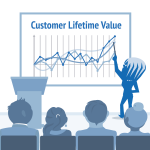Ambition – The Fuel That Drives Growth
 People often ask me why some companies grow and become billion dollar corporations while others struggle to feed their owners?
People often ask me why some companies grow and become billion dollar corporations while others struggle to feed their owners?
In my upcoming book about the Damgaard brothers (they started their company Damgaard Data in 1984, did a joint venture with IBM in 1994, divorced from IBM in 1998, did an IPO in 1999, merged with Navision Software in 2000 and was acquired by Microsoft in 2002 for over a billion dollars), I take my readers behind the scenes and show in detail how business success is made.
The tale about the Damgaard brothers reveals just how unpredictable the path to success is, but it also clearly illustrates that ambition is the fuel that drives the growth.
Don’t mistake greed for ambition
Do not mistake ambition for greed. Greed is the driving force for acquiring the most for yourself. Ambition is an entirely different animal.
Ambition is the burning desire to achieve something that stands out, and that is extremely valuable to others and thereby to yourself – something that leaves a positive legacy. It may not be related to monetary values, but in business, there often is a close relationship. The Damgaard legacy lives on today, and whenever a company implements Microsoft Dynamics AX, it carries its name forward.
Timing is everything
A business success obviously requires more than ambition. It needs a great product launched at a time when the market is ready and where the bootstrapping can be accomplished with the resources available. Getting this combination right is not easy. It may take several attempts before the entrepreneurs find their breakthrough.
Most run out of money before they find it and must start over again. The Damgaard brothers got it right the first time (and so did their colleagues at Navision Software, too). Starting the Damgaard company was not the result of a burning ambition, but growing the company surely was.

Erik og Preben Damgaard
Erik Damgaard was 23, and Preben Damgaard was 21 years old when they started in 1984. When they sold to Microsoft 18 years later, the company (merged with Navision Software) had a staff of over 1,500 people, subsidiaries in 32 countries and turned over close to 2 billion kroner (€270M) in annual revenue with a profit margin of more than 20%. They had been through much-troubled cooperation with IBM, a very successful IPO, a painful profit warning and a merger with their fiercest competitor Navision Software (the merged company continued under the name Navision which was then acquired by Microsoft).
Global market leadership
 The ambition of the Damgaard brothers was to become the global leader in the market for ERP systems to companies with revenues of between 5 and 500 million dollars. With that ambition as their leading light, they had to learn the trade of all the disciplines required to grow a business faster than the market and faster than their competitors (of which many had the same ambition). It is like taking off in a Cessna and rebuilding it into an Airbus 380 while you are still airborne. Delivering on such an ambition requires studying new approaches, listening to and learning from others. It requires developing the art of leadership and delegation. It requires that you stop doing the things that worked well yesterday but now stand in the way. It requires saying goodbye to people that did well in the past but no longer matches the challenges going forward. It requires that you look in the mirror every morning and consider if you have what it takes to drive the business forward to fulfil that ambition.
The ambition of the Damgaard brothers was to become the global leader in the market for ERP systems to companies with revenues of between 5 and 500 million dollars. With that ambition as their leading light, they had to learn the trade of all the disciplines required to grow a business faster than the market and faster than their competitors (of which many had the same ambition). It is like taking off in a Cessna and rebuilding it into an Airbus 380 while you are still airborne. Delivering on such an ambition requires studying new approaches, listening to and learning from others. It requires developing the art of leadership and delegation. It requires that you stop doing the things that worked well yesterday but now stand in the way. It requires saying goodbye to people that did well in the past but no longer matches the challenges going forward. It requires that you look in the mirror every morning and consider if you have what it takes to drive the business forward to fulfil that ambition.
Business ethics
Ambition is the leading star, and everything else becomes variable. But you must still play by the book of ethics. Making a dent in the universe while leaving a trail of broken people and other casualties along your journey doesn’t count.
I will claim that the Damgaard brothers and also the founders of Navision Software made a serious effort to apply healthy ethical principles in the way they conducted their business. I will also claim that their principles and behaviour constitute a major portion of the recipe for their financial success. Taking care of the people around you always pays off in the long run.
The book will be published in Danish on September 1st, 2017 and in English in 2018.








